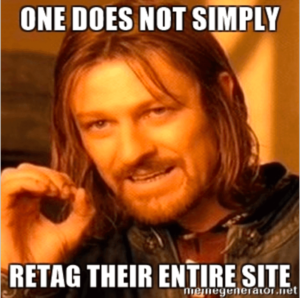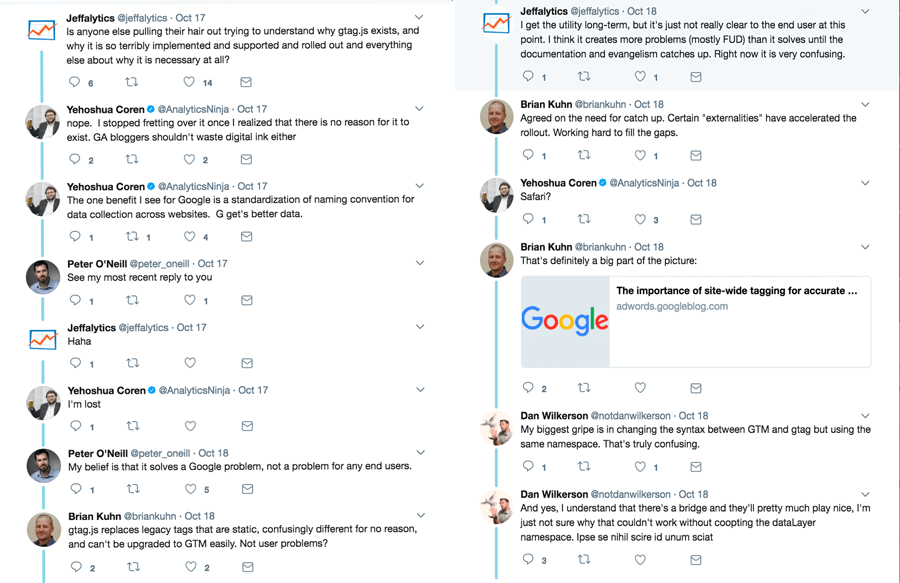The other day I noticed something new in my Google Tag Manager account
A new tag template was available called “Conversion Linker” and there wasn’t a lot of documentation available. So I dove into figuring out what it all meant. This article is a summary of what we learned going down the rabbit hole of the most recent tracking change in Google AdWords.
If you use GTM, you may have noticed this new Conversion Linker option in your tag templates. It’s a very basic tag that doesn’t require much configuration, which also makes it easy to miss.
If you’re not using GTM, this article will still provide value, because we explain more details behind Google’s Conversion tracking changes in AdWords.
Conversion linker: how did we get here?
The Conversion Linker tag is the result of a significant change in how AdWords conversions are tracked, from third-party to first-party cookies.
The first-party cookie change applies to every user of Google AdWords who is tracking conversions (this should be everyone).
If you want to make sure you are tracking conversions accurately in the future, you will want to know which options to use within your AdWords account.
Google has introduced Conversion Linker with very little fanfare, so it’s been left to the community to develop a list of use-cases for when it is necessary. Otherwise these changes will remain quite confusing.
I want to help clear up some of this confusion.
The video and post below will guide you through the new changes in AdWords conversion tracking, why they happened, and explain which conversion tracking option is best for your needs. We also take a look at how to set-up Conversion Linker.
Why is Conversion Linker important?
Conversion Linker, and many of the other recent Google updates are the result of Intelligent Tracking Prevention [ITP] being rolled out in the Safari browser.
![]()
Intelligent Tracking Prevention
In September, Apple launched an update to the Safari browser. The Safari update includes a new Apple initiative called Intelligent Tracking Prevention (ITP). ITP cracks down on tracking website visitors across multiple websites using third-party cookies.
More precisely, ITP dumps any third-party cookies, which don’t contain login information from a users browser after 24 hours. ITP also drops all third-party cookies from the Safari browser after 30 days.

ITP has some pretty big ramifications. Until now, AdWords data has been tracked using third-party cookies. The purging of third-party cookies could prevent us from tracking the source of AdWords conversions that occur in Safari. This would break AdWords click attribution on almost half of all mobile searches.

Google’s response to Intelligent Tracking Prevention
Apple announced their intention to implement ITP in June. Apple’s announcement only gave Google a few months to build an entirely new way to track AdWords conversion data.
Apple essentially forced Google’s hand. Changes to the AdWords interface and conversion tracking technology were necessary to comply with ITP and keep AdWords data intact.
Google’s rush to get their new technology in place is probably why we’ve been given very little support documentation. Additionally, Google likely wanted to avoid questions from their millions of users about the AdWords changes.
AdWords conversion tracking moves to first-party cookies
Google’s solution to ITP is to push all the AdWords ad click data that used to get tracked via a third-party cookie into a first party cookie. This is the same way Google Analytics tracks conversion data. Tracking via first-party cookies falls into compliance with ITP.
To move to tracking AdWords data in first-party cookies, Google had to provide a new tracking method to it’s AdWords users.
Google’s solution involves three options, one of which you’re probably using, and two new additions.
Tracking AdWords Conversion data in compliance with Intelligent Tracking Prevention
Option #1 – gtag.js – one tag to rule them all!

We talked about gtag.js briefly last week, but let me provide a little more clarity about how it works.
gtag.js was built to combine both AdWords tracking and Google Analytics tracking into one tag. It does not necessarily replace the old Universal Analytics tracking code, it just sits on top of it. Kind of like a new coat of paint.
gtag.js is like an easier version of Universal Analytics or a dumber version of Google Tag Manager. It’s less technical to implement, which means the process should be easier to grasp for many advertisers.
By using the same codebase for Google Analytics and Google AdWords, you can track your AdWords conversions via first-party cookies. But it also adds a requirement of installing a second tag for tracking conversions on every page you want to track.
[To learn more about gtag.js, you can read our recent post on Jeffalytics. You can also follow Jeffalytics on Twitter to keep up with my rantings.]

Option #2 – Link Google Analytics to your Google AdWords account
If you are using AdWords, you probably already have this setup. According to Google, if you have your accounts linked, you don’t need to do anything to comply with ITP. This is because of auto-tagging GCLID parameter, which links data deeply between your accounts.
If you haven’t done this yet, it’s easy to setup. In your AdWords account select the gear icon, then choose linked accounts. From there just match your AdWords account to your Analytics account and your setup is done.

Option #3 – The newest addition, Conversion Linker
According to Google, Conversion Linker exists for AdWords users who:
- Have not linked their AdWords and Google Analytics accounts
- And have not retagged their site using gtag.js
If you have already configured options one or two above, Google says that you do not need to use conversion linker. But if you haven’t set up one of the other AdWords tracking mechanisms, and you’re using Google Tag Manager for AdWords conversion tracking, you should use Conversion Linker.
*Note: It is unclear in the documentation if you need conversion linker while using AdWords tag templates in GTM if you also have deep integration between GA and AdWords. For now, I would err on the side of caution and enable Conversion Linker if you are using AdWords conversion tag templates in GTM.
The Conversion Linker tag effectively pushes all your AdWords tracking data into a first-party cookie.
The tag is easy to setup. Select the Conversion Linker tag in the Google Tag Manager configuration menu. Then choose a trigger for the tag to fire on, and your tag is installed. As usual, you should check and debug your tags and triggers before publishing.

Bottom line for tracking AdWords conversion data in the new ITP environment
You need to choose a tracking solution that utilizes first-party cookies. The three options Google supports are:
- gtag.js
- Deep linking of your AdWords and Google Analytics accounts
- Conversion Linker tag in GTM
If you have questions about Conversion Linker, first-party tracking changes, or even a correction to this article, please leave a comment.
Your questions will help us all understand what’s going on, and help us make the right adjustments. Ask away!
